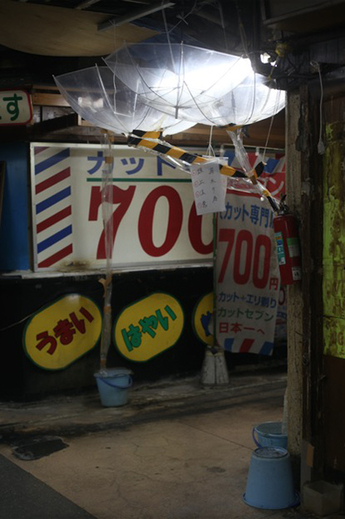-
From Current Issue
-
- Editor’s Letter Fire in the Heart
- Reviews I Gusti Ayu Kadek Murniasih
- Reviews 11th Seoul Mediacity Biennale: “One Escape at a Time”
- Dispatch Networked China
- One on One Monira Al Qadiri on Yukio Mishima
- Essays The rise of independent art spaces in pandemic-era Shanghai
- Features Tuan Andrew Nguyen
- Table of Contents
- Web Exclusives
- Archive
- Subscribe

R
E
V N
E
X
T
Parts of Yuko Mohri’s recent work recall the form and motion of sōzu—pivoted bamboo fountains that fill with water until they tip into motion. Now, after a steady accumulation of accolades, the Japanese installation artist’s career likewise appears to be in full swing.
Aside from receiving consistent attention in her native country, in the last two years Mohri has mounted exhibitions in Taipei and New York, and has undertaken residencies at London’s Victoria and Albert Museum and Camden Arts Centre. She was also included in Apollo Magazine’s 40 Under 40 Asia Pacific list. In “Moré Moré [Leaky],” Mohri’s first solo show in the UK, she has taken over London’s White Rainbow gallery with a new iteration of the series that won her the Nissan Art Award in 2015.
The series stems from a fascination with the Tokyo metro system that has conveniently aligned with two strong themes in Mohri’s previous art: unseen, circuital forces and the use of found objects. The result is a heavily idiomatic body of work highlighting the interplay between human design and nature.
Tokyo’s metro system is emblematic of crowded public transport. During rush hour, the commuting workforce it serves embodies the invisible forces of labor in the so-called circuits of capital. In a twist highlighted by Mohri’s research, the refuse of this human activity, in the form of discarded commodities, feeds back into the loop and provides material for the subway’s informal maintenance.
Due to relentless tremors and earthquakes, as well as heavy rainfall, the Tokyo metro is subject to leaks. For years, ad-hoc repairs have sprouted and vanished like mushrooms, and Mohri took an interest in how such impromptu solutions repurpose objects and insert them into the system to redirect errant water.
A small selection of photographs from her research project on this phenomenon was on display for the first time at White Rainbow gallery. These images showed umbrellas used as funnels and sheet plastic haphazardly patched like thick spider webs over light fixtures, then scrunched and taped into makeshift tubes elsewhere. There was the sense of something functionally and aesthetically organic, an adaptive system growing from the relationship between people and the forces surrounding them.
Mohri captured the essence of this process in the exhibition’s main installations, which consisted of three wooden frames, each constituting a self-contained “ecosystem” with its own pump-driven water flow. The jocular addition of a sponge and a mop head on the floor apart from the three pieces made the gallery space itself, like its contents, evocative of the leaky metro, while also providing the means to resolve any real life “leaky situations,” as Mohri called them.
Despite their thematic and formal similarities, each work appeared singular in its use of materials. The Fallen Water Given #5 (2017), which included a wheel with a pail attached that would tip like a sōzu after collecting enough water, hinted at the ludic complexity of a Rube Goldberg machine. The Fallen Water Given #4 (2017), a simpler offering, consisted of a modified rubber boot, some tubing, and a translucent sheet reducing them to silhouettes from one side. Some pieces appeared to intimate more of a human absence than others; some objects, like a steel watering can, attributed eubstance to the constructions, while a plastic bag elsewhere undermined it. The use of light bulbs in places seemed a superfluous aesthetic touch, but is hard to disparage when this aesthetic was so strong.
Despite these effects, there was an improvisational quality to Mohri’s installations that belied such deliberations. The ad-hoc, functional arrangement of objects was an incremental response to the water they channeled. It was even possible to conceive of the water as the true material of these pieces, worked by ostensible contraptions. This being the case, the artist doesn’t merely explore natural forces, but sculpts them.
The strength of Mohri’s practice is in her awareness not just of the unseen energies around us, but the special means by which they become visible. Exposing some of the many motions and circuits at work in the modern city, her treatment of water also recalled the florescent dye used by doctors to highlight the workings of the circulatory system, revealing a motile harmony.
Yuko Mohri’s “Moré Moré [Leaky]” is on view at White Rainbow, London, until March 11, 2017.
To read more of ArtAsiaPacific’s articles, visit our Digital Library.


![YUKO MOHRI, Moré Moré [Leaky]: The Falling Water Given #5 (detail), 2017, wood frames, found objects and water pump system, dimensions variable. Courtesy the artist and White Rainbow, London.](/image_columns/0022/2977/3._the_falling_water_given__5__detail__2_567.jpg)



